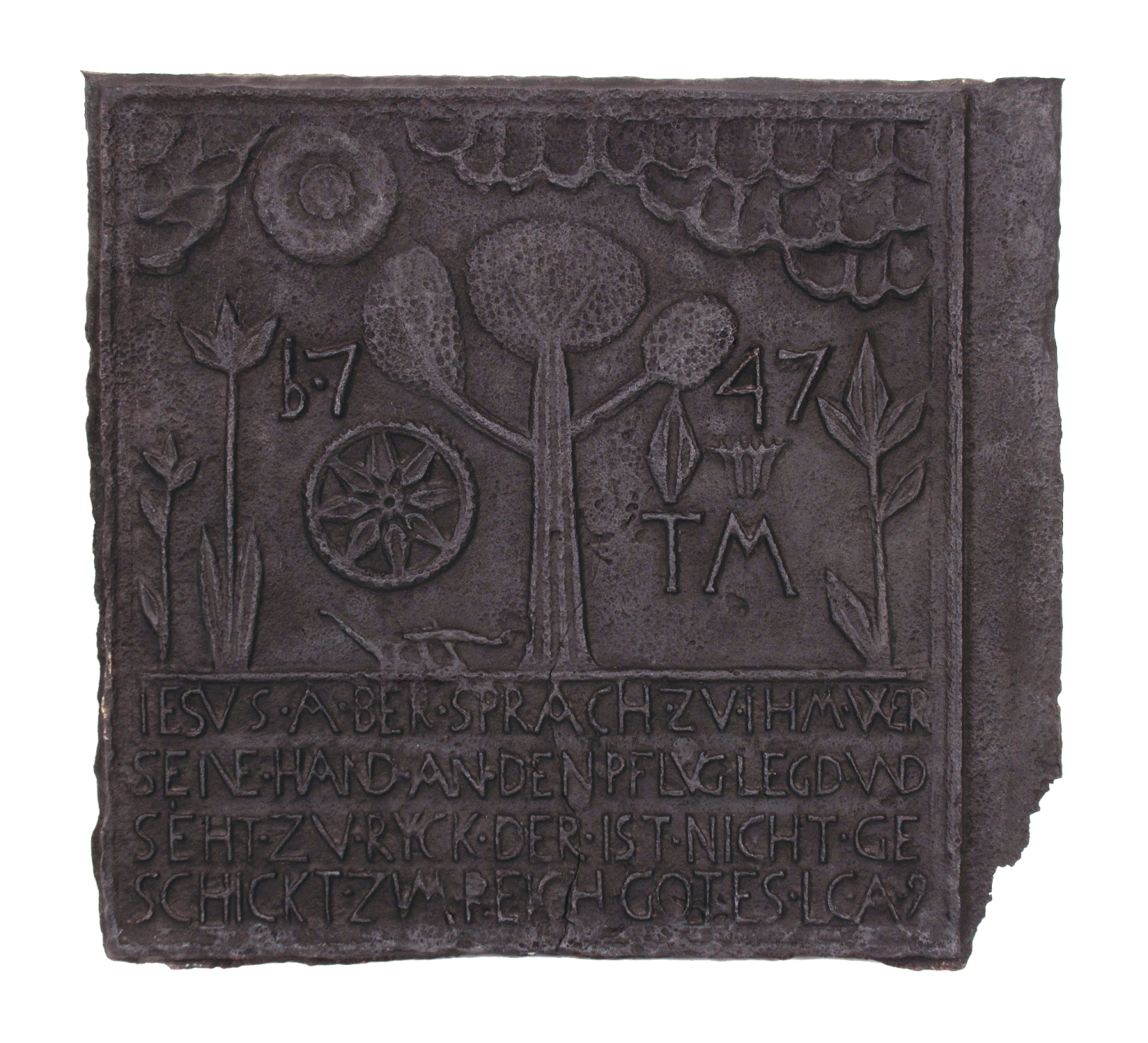
| |
MID-18th CENTURY CAST IRON FIRE BACK WITH A LARGE, THREE-LIMBED TREE, A PLOW, TULIPS, AND BIBLICAL VERSE; ATTRIBUTED TO IRONMASTER THOMAS MAYBURY AT HEREFORD FURNACE, BERKS COUNTY, PENNSYLVANIA, DATED 1747 |
| |
|
| Dimensions (inches): |
26" x 28.75" x .5" |
| Description: |
|
This beautiful, 18th century, cast iron, Pennsylvania German stove plate features a large, three-branched tree beneath the sun and clouds, surrounded by a pinwheel-like circlet, a plow, and tulips. Dated 1847, the initials “TM” appear in the right register, beneath a diamond-shaped device—perhaps a spear head or trowel—and what is either a more elaborate tulip or perhaps a crown or basket. Many stove plates of this region, in this period, illustrated biblical scenes and/or Biblical verse that conveyed moral lessons. Text along the lower register, translated from the Pennsylvania German, reads as follows:
“And Jesus said unto him: No man having put his hand to the plow, and looking back, is fit for the Kingdom of God.” Luke 9”
A fragmented plate, produced with the same mold, is documented as Figure 52 in a quintessential text on fire backs by Henry C. Mercer (1856-1930), entitled “The Bible in Iron, or, The Pictured Stoves and Stove Plates of the Pennsylvania Germans,” (1914, Bucks County Historical Society, Doylestown, PA). Part of the collection of the Museum of the Young Men’s Missionary Society* at Bethlehem, PA, Mercer describes its artistry as having “features of [the] most irregular and childlike of any of the stove patterns yet seen.” Several stoves and/or plates bearing the name Maybury and/or Hereford are documented among the 236 examples illustrated in the Mercer text. In the commentary beneath Figure 169 (p. 103, marked “Hereford Furnace : Thomas Maybury”), he states the following:
“The ten-plate stove, Figure 180, is marked Thomas Mayberry, Hereford, while the eccentric five-plate pattern, Figure 105, is cast with the name Hereford between the initials W. M., probably for William Maybury, and if it were not for these uninteresting plates, and an old piece of pig iron found at the bottom of a well at Hereford, Berks County, Pa., now at the Berks County Historical Society, marked with the name Hereford, the very existence of the obscure Hereford furnace, on the West Branch of the Perkiomen Creek in Hereford Township…might be doubted.” Mercer continues: “Swank and Pearse make no mention of it,** but, according to ‘Old Charcoal Furnaces in Eastern Berks County, by Winslow Fegley, an old map published in 1753 shows that the Hereford works, now long in ruins, stood there at that time [with Maybury as ironmaster, or so he relates on p. 50 per the Fegley-documented map].***
The naïve nature of the imagery, centered on the tree that Mercer describes as being “cactus-like,” is one of the two primary factors the makes it such a great piece of American, Pennsylvania German folk art. In spite of the suggested lack of sophistication, the casting has great artistic balance in its myriad of elements, both text and figural, pleasantly distributed and visually compelling. The plate retains strong texture, devoid of the sort of wear that makes them illegible, though at the same time, the rough perimeter and the fragmentary state of the lower right edge contribute their own measure of appeal to the presentation. All-in-all, a wonderful example of pre-Revolutionary War ironwork from an identified, Southeastern Pennsylvania maker, and a great addition to any advanced folk art collection.
* The Museum of the Young Men’s Missionary Society appears to no longer exist, possibly having been absorbed by Historic Bethlehem Museum & Sites.
** Refers to two texts: (1) “History of the Manufacture of Iron in All Ages: And Particularly in the United States for Three Hundred Years, from 1585 to 1885” by James Moore Swank (1884, Self-Published, 261 South Fourth St., Philadelphia), and (2) “Concise History of the Iron Manufacture of the American Colonies up to the Revolution : And of Pennsylvania until the Present Time (1876)” by John Barnard Pearse (1876, Allen, Lane & Scott, No. 233 South Fifth St., Philadelphia).
*** In order to document other Mayburys, Mercer also states (p. 103): “Swank speaks of a Thomas Maybury making sheet-iron at Mount Holly Forge, in New Jersey, destroyed by the British in 1775, another Thomas Maybury building Green Lane Forge, on Perkiomen Creek, Montgomery County, in 1733, and another Thomas Maybury petitioning the General Assembly of Pennsylvania, with a number of iron masters, for protective duty on iron, in 1785. The William Mayberry, of Figure 105, appears to have been a Justice of the Peace, shareholder at Shearwell Furnace, at Oley (Pennsylvania, Berks County) In 1760, and early iron master in Berks County, according to Mr. B. F. Owen, and Swank says that a Jonathan Maybury and Co. owned Fountain Forge in Donegal Townsh’p, Westmoreland County, Pa., before 1812.” None of this disputes the Thomas Maybury of Hereford Furnace or his making of the other example of the fire back that is the subject of this narrative, illustrated as Figure 52.
Condition: Wear and loss about the perimeter, especially in the lower, right-hand corner, beyond the characters and imagery. There is an irregular crack extending from the lower edge, vertically through the text, into and just beyond the tree. This is an extremely solid casting, very heavy, and does not lend a sense of instability in any way. The back is painted rust red.
Mounting: There is no mount presently. I can have a wall mount constructed at the buyer’s request. |
|
|
| |
|
| Primary Color: |
black |
|
| Earliest Date: |
1747 |
|
| Latest Date: |
1747 |
|
| For Sale Status: |
Sold |
|
| Price |
SOLD |
|
| E-mail: |
info@jeffbridgman.com |
|
 |
|
Page Views:... 551 |
|


